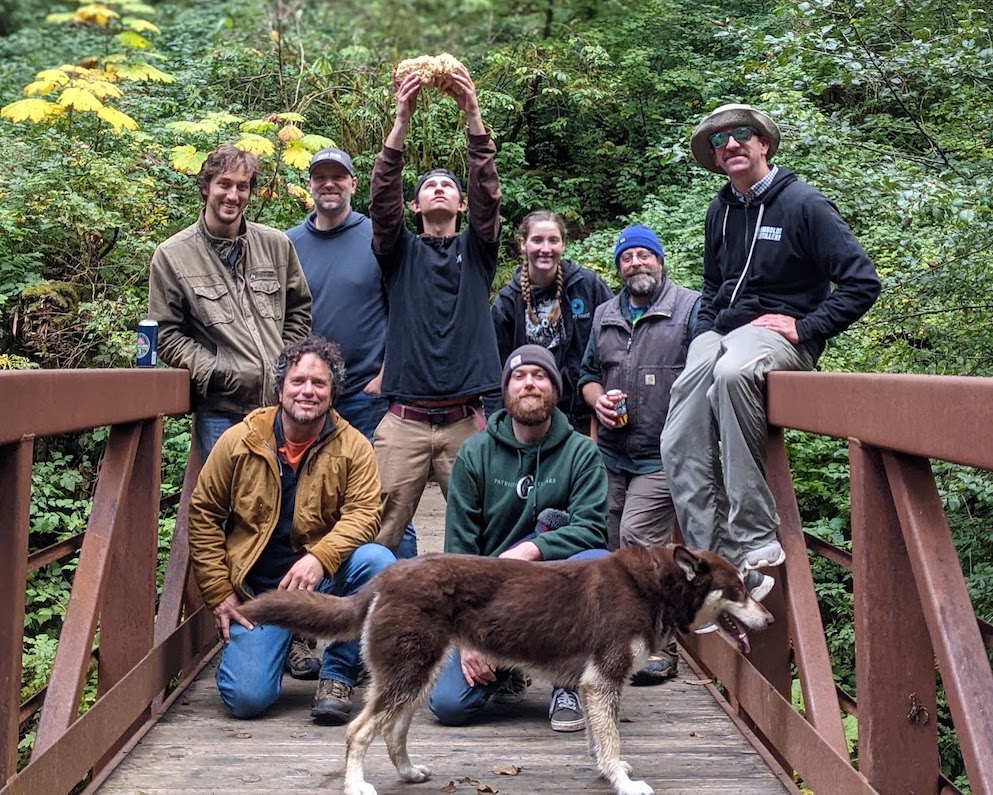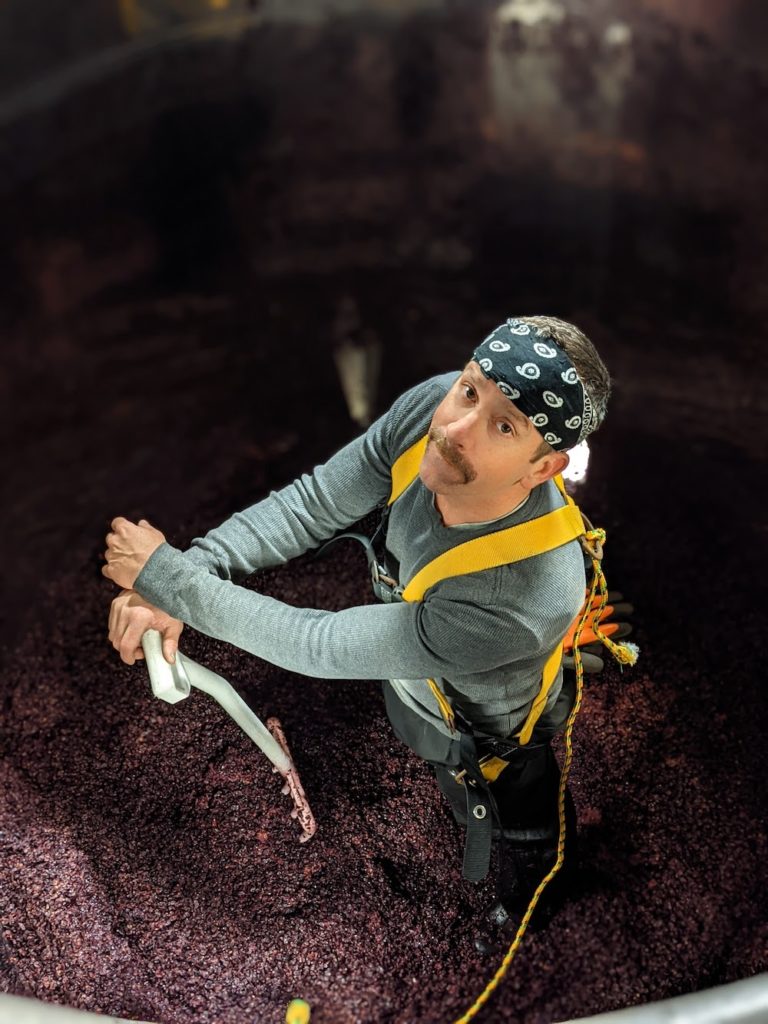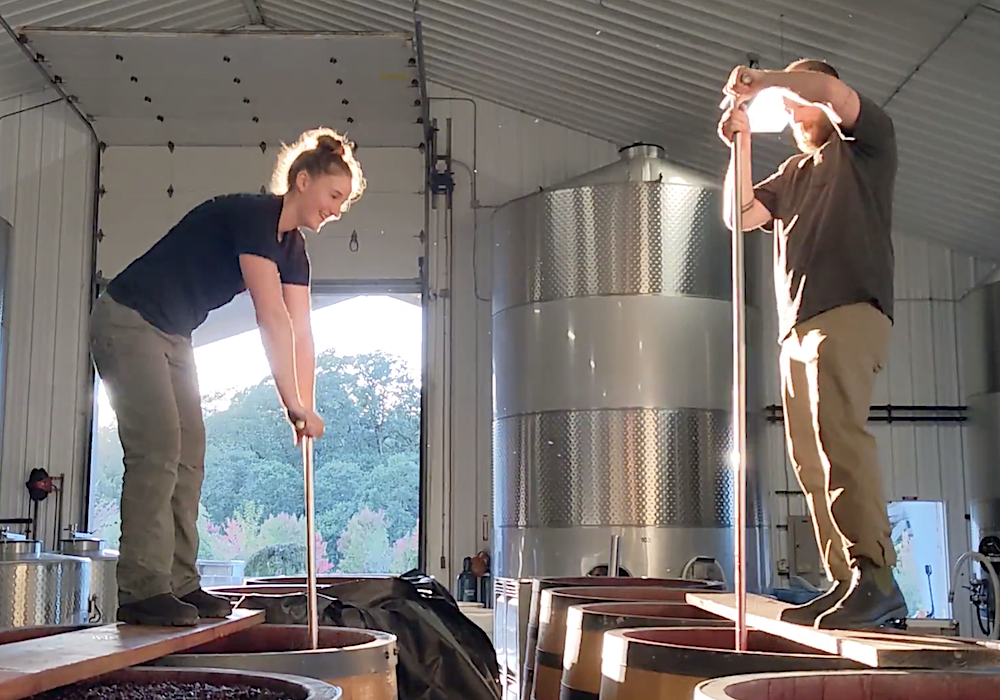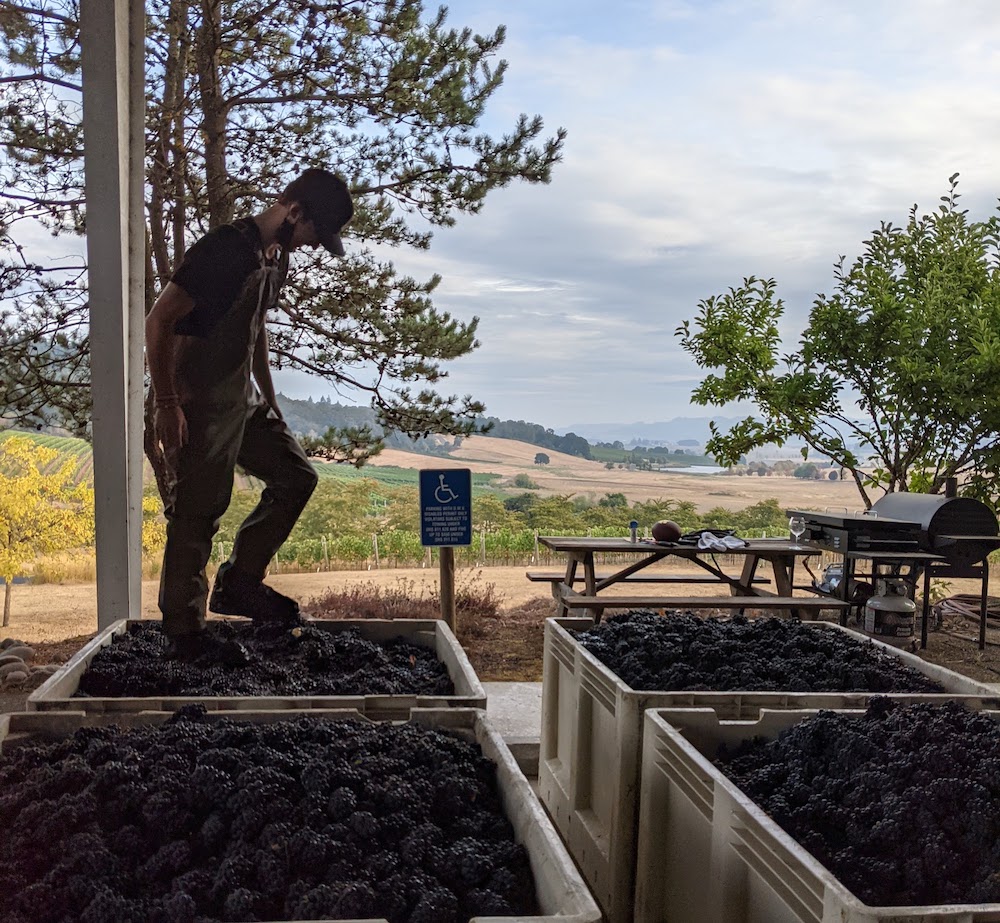March 4, 2022 – Why are you going back?
The question felt like a challenge. Perhaps that’s because it came from my mom, who enjoys a motherly gift for inspiring me to rethink.
I thought I knew. More than anything, returning to wine harvest at Left Coast Estate in Oregon’s Willamette Valley would allow me to stack positive outcomes.
I’d get paid to exercise—shoveling grapes, stomping grapes, punching down grapes. I could listen to books and podcasts all day. I could jot in my journal between tasks. I’d be too busy to spend any money. I’d be remote by design, clear of many pandemic stresses. I’d be put up in a cute wine country town (McMinnville) in a beautiful part of the Pacific Northwest. I’d be rejoining a great group of humans. I’d get to experience a harvest that wasn’t terrorized by wildfire and pre-vaccine COVID. I’d be fed well. I’d get to drive a forklift.

Thanks to my original harvest odyssey a year previous, I’d also enter with a firsthand understanding of the almighty grind I was getting into. As I wrote in a far-ranging Special Report: Left Coast Lessons From a Surreal 2020 Harvest, “Winemaking is sticky, damp and sweaty, humbling and empowering, boring and exhilarating, sobering and intoxicating, deeply systematic, occasionally bloody and often exhausting. Glamorous it is not.”
But it turns out that while I had these linear reasons for going back, I didn’t know how much I actually needed to, not so much in a logical way as in a spiritual one.
Make no mistake. The early mornings and late nights, the yellow jacket stings and inevitable injuries, the 7-day work weeks and 13,000-pound press loads, the bathroom cleaning and dumptruck scubbing…aren’t for everyone.
But something about it really works for me.

In the harvest journal I kept on my phone, under the title “Day 14” appears this: “Feeling free.” The two words snap me back to the moment on the crush pad when I tapped them in. I was experiencing both a lightness and a focus I hadn’t in a while. Something lifted that I hadn’t noticed was there. I remember observing for the first time in a long time that I was feeling more engaged, more embodied, more alive. Some sort of reset was happening.
I’m not completely sure why. But something about the chance to toil quietly and steadily for days on end, to step away from spinning the wheel, was liberating and clarifying. Maybe all that time to think helped me stop overthinking.
The Zen version goes something like, “Before enlightenment, chop wood and carry water. After enlightenment, chop wood and carry water.” Or in this case, “Squish grapes, clean equipment.”
I’m not claiming any enlightenment, rather sharing a little meditation that, at least for this grunt, can have big benefits.

But with harvest months in the rearview, why am I sharing it now? One key reason: A different reset—with its own clarifying powers—was recently thrust upon me. Last month I tested positive for COVID and had 11 days of isolation to stop, think, take stock and (yes) review some wine harvest journal entries.
In the journal appear various quotes from what I was reading and listening to, like this one from German novelist Thomas Mann: “What is success? It is an inner and indescribable force, resourcefulness, power of vision; a consciousness that I am, by my mere existence, exerting pressure on the movement of life about me. It is my belief in the adaptability of life to my own ends. Fortune and success lie within ourselves. We must hold them firmly—deep within us.”
I thought about how lucky I am to be able to take a month to work the harvest. I thought about how lucky I am to have my health—and how important it is to remember how many are still dying and/or risking their existence to save lives, as others declare they’re so done with COVID. I thought about how lucky I am to have the type of space that makes quarantining more manageable than it is for so many.
I thought about how lucky I am to have the chance to keep writing, reflecting, breathing, doing. My pal dropped off some juice, probiotics and tea the other day. The first Yogi Tea I steeped had a tag with a little thought that felt right on time, “Sometimes a perfect blessing will arrive in the disguise of a mischievous intruder.”

I had other things I thought about writing about for this week’s column. But it’s been an emotional morning that keeps bringing me back to the type of reflection I experienced in quarantine—and has only intensified as I, along with the world, gape at the unnecessary violence and loss of life in Europe.
Yesterday my parents and I knelt around a very special member of the family, sniffing, crying and stroking her soft, soft fur as the vet’s injection gently carried her over to the spirit plane after a long and happy life. Yes, we are deeply sad at her passing, but—keeping with the theme—also wildly grateful we shared so much joy and love with her.
Georgia the springer spaniel loved to snuggle, loved to tromp the beach and forest, loved to chase her ball. She would’ve been raised to be a show dog if her paws weren’t so big—giving her the perpetual look of a puppy to match her youthful disposition—and if she wasn’t so sweet and deferential. (Apparently show dogs should be cocky and competitive.)
Those lessons are part of her legacy: Stay youthful at all ages; ego ain’t your amigo.
But the most enduring gift she leaves behind is more kinetic—and the number one way I know she enjoyed her glorious run on the planet: She wagged her little stubby brown tail with the white dot on the end more than any dog has ever wagged its tail, period.
So, show dogs out there, enjoy those medals. But know gratitude has never had a better champion than Georgia.

There are other key motivations that sent me back to the wine harvest. For one, Left Coast winemaker Joe Wright needed what he likes to call “warm bodies,” and he invited me.
Two, his resourcefulness is both instructional and inspiring. Wright is a master winemaker, but the title doesn’t really do his skill set justice. On any given day he’s also a welder, plumber, scientist, philosopher, farmer and tech geek trying to figure out the new $300,000 wine press’s computer interface. On my first day of this harvest he was the one towing the dump truck from where I got it stuck in the compost pile; on the last day of my harvest he was extracting the forklift from the garden bed where my fellow cellar intern marooned it.
But he does also enjoy one of the most sensitive palates I’ve encountered—and an impressive familiarity with Pinot Noir specialists across the West. When he estimated he knows 90 percent of them, I asked him to highlight his favorites from our part of California, a Pinot-country sister-to-the-south.
Here are his three favorites from the Monterey Bay area, with notes from Edible Monterey Bay’s resident wine expert, Laura Ness, who writes Friday’s Grape Escapes newsletter column.
Thomas Fogarty Winery • Laura Ness: ”If you want to know what the coolest vineyards in the Santa Cruz Mountains taste like, Fogarty is a great lens. Nathan Kandler is a master at single vineyard expression: Windy Hill exudes perfumey and beguiling aromatics of pine and forest floor, with brisk red fruits and a tight fistedness belying structure. Rapley Trail is exotic spice, pine forest and pomegranate. Will’s Cabin is quixotic earth, mushrooms, racy strawberry rhubarb pie and baking spice.” • fogartywinery.com
Rhys Vineyards • LN: ”Jeff Brinkman knows a thing or two about Pinot Noir from the Santa Cruz Mountains and Anderson Valley, and now Corralitos. He processes multiple blocks from each of the seven Pinot Noir vineyards in one ton fermenters separately to preserve and understand their character. Alpine Vineyard makes taut, black fruit and pine influenced Pinots, while Horseshoe Vineyard tends towards fleshier and open knit wines.” • rhysvineyards.com
Bernardus Winery • LN: ”Dean DeKorth has spent his entire tenure at Bernardus growing up with the Santa Lucia Highlands vineyards as they matured, and along the way, learning the nuances of each site. Rosella’s is a favorite for its beguiling perfume and riot of spice, while Sierra Mar has a vibrant sweet core of lush, mouth-filling red raspberry.” • bernardus.com
More at leftcoastwine.com.
About the author
Mark C. Anderson, Edible Monterey Bay's managing editor, appears on "Friday Found Treasures" via KRML 94.7 every week, a little after 12pm noon. Reach him via mark@ediblemontereybay.com.
- Mark C. Andersonhttps://www.ediblemontereybay.com/author/markcanderson/
- Mark C. Andersonhttps://www.ediblemontereybay.com/author/markcanderson/
- Mark C. Andersonhttps://www.ediblemontereybay.com/author/markcanderson/
- Mark C. Andersonhttps://www.ediblemontereybay.com/author/markcanderson/



